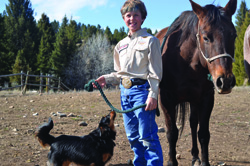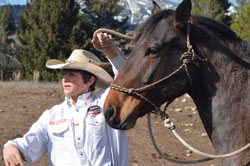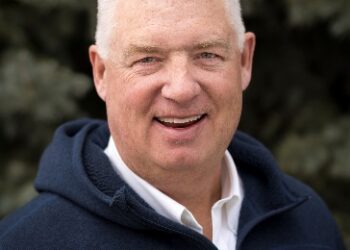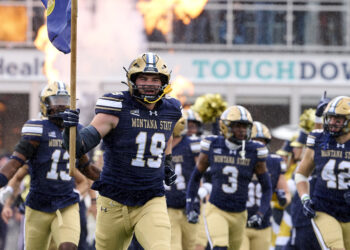By Abbie Digel, Mountain Outlaw Editor
Photos by Anna Middleton
It’s a blustery day in early March. James Ramirez is waiting in a chilly, dim arena 10 miles south of Livingston, among about 50 other middle and high school boys. They’ve been at the Rockin’ 3 arena for two days, at the Joe Beaver Roping Clinic, practicing calf roping skills. They wait for their turn, sometimes for hours, to ride and rope in front of world-champion calf roper Joe Beaver.
Beaver’s thick Texas drawl illuminates the arena every time he yells, “good loopin’ boy!” Perched on their horses, some of the young riders goof off, others are stern and focused as they wait their turn.
James is up next. His father, Ed, stands cool and distant, leaning against a gate at the edge of the arena, watching with a slight smile on his face, his eyes squinted. With a clank of the metal gate, a black calf takes off, running for the opposite end of the arena. James gallops toward it at full speed, a piggin’ string clenched between his teeth. His free arm whips his lasso around so fast it blends in with the air.
He ropes the calf’s neck, and it reels back as if hitting a wall. James jumps off his horse, runs to the calf, lifts it in the air, and drops it to the ground with a thud. He ties its ankles, tightening the piggin’ string with one thrust of his arm. He walks away, head hung low, and the small crowd of parents clap.
“Not bad, not bad,” Beaver says. He approaches James, placing his hand gently on his back, whispering. Beaver’s hands swing in the air, mimicking roping motions. Ed watches, and nods.
The next rider is up. “Think of that gold haired beauty with the BMW and the American Express Card waitin’ for ya,” Beaver yells. And the rider takes off after the running calf.
March was James’s fourth month calf roping. In that time he’s also worked with Montana calf ropers like Mark Sammons of Choteau and Scott Lynch, from Ronan. James ended up second place in his age group that day.
—-
 The Ramirez family has lived in Big Sky for two generations. James’s mother Kristen still lives in the same home on five acres just off Highway 191 where she was raised. The family owns and runs Ramirez Property Management, and the rest of their time is spent living and breathing rodeo.
The Ramirez family has lived in Big Sky for two generations. James’s mother Kristen still lives in the same home on five acres just off Highway 191 where she was raised. The family owns and runs Ramirez Property Management, and the rest of their time is spent living and breathing rodeo.
Kristen has always had horses, and Ed, who grew up in Malta, is a rodeo veteran. He competed growing up and attended college on a rodeo scholarship. Now, while he still competes, he mostly he acts as chauffeur, horse groomer and head rodeo coach for James, 12, and his younger brother Luke, who’s 9.
James and Luke have been taking care of horses and riding them since they could walk. Most of the year, when the boys aren’t in school, the Ramirezes are on the road with a horse trailer, four dogs and two to four of their 10 horses, headed to a rodeo.
Buckets, Dyna, Oakely, Mator, Sammy, Tuff, Tugboat, Dunny, Breaker and Dixie are all horses in the family’s herd. Some of the animals were bred and raised by Kristen’s mother, Ann. One, Tugboat, was a gift from the boys’ godfather, local horseman Jerry Pape. The 23-year-old horse has taught “many in this valley how to rope,” Kristen says. Now retired, Tugboat is living the good life, “belly deep in grass.”
 The Ramirez boys compete various classic rodeo events. James competes at the junior high level in team and calf roping, goat tying, barrel racing, flag race, ribbon roping and bulldogging. Luke competes in the junior league, in goat tying, barrel racing, breakaway roping and team roping. They belong to the Southwest Youth Rodeo Association, the Montana Junior High School Rodeo Association and the Wrangler Team Roping Association.
The Ramirez boys compete various classic rodeo events. James competes at the junior high level in team and calf roping, goat tying, barrel racing, flag race, ribbon roping and bulldogging. Luke competes in the junior league, in goat tying, barrel racing, breakaway roping and team roping. They belong to the Southwest Youth Rodeo Association, the Montana Junior High School Rodeo Association and the Wrangler Team Roping Association.
“There are families from all over the state and parts of Idaho and Wyoming who compete with us,” Luke said. “We have friends all over the state and we met them through rodeo.”
The boys practice several nights a week and compete every weekend from March through October. During the winter, Ed and Kristen drive them to an indoor arena in Bozeman a couple days a week; in the summer, they spend most of their time in an outdoor arena near Bucks T-4.
James taught his younger brother how to tie a goat, and also how to practice roping on dummies.
“If it has legs we rope it,” Luke says.
“It’s just another day,” James says about the competitive nature of the sport. They also participate in soccer, basketball, skiing, snowboarding and hunting, but rodeo is top priority.
“Rodeo is not a sport,” Ed says. “It is who we are, it is a way of life.”
But all over the state, rodeo is coming to a standstill in larger communities.
“Rodeo in this area is a dying breed,” Kristin says.
While there are some families involved in the Gallatin Valley, rodeo is primarily found in eastern and northern Montana. Raising horses in Big Sky is challenging because of the climate, distance to medical facilities, and the price of real estate.
“Big Sky is no longer known for ranch land, and most don’t want to live by horse pens,” Kristen said. “But the animals are part of our family. We will run a horse down the canyon to a veterinary hospital in the middle of the night if we have to.”
Managing the animals is a full time job in itself, Ed says. Everyone in the family has a job at home and on the road.
“We get up, and feed the horses before we feed ourselves,” Kristen says.
In the winter months, they give the horses a short break, sending them away to pasture in Dillon and Sheridan, Mont., but by early March, the horses return. And similar to human athletes, equine athletes must be conditioned after a break. The process includes introducing additional exercises, changing feed and vitamin regimens, grooming, and fitting horseshoes and hoof care. Come spring, the boys also check their equipment: saddles, boots, hats, blankets and buckets are all in need of cleaning, oiling or repair.
A trampoline and swing set sit next to the practice arena in the Ramirez’s lawn. There, the brothers practice their groundwork–skills related to rodeo that can be perfected without an animal.
“The fun part comes when you get to put it all together on the back of a horse,” James said.
Luke is just beginning to rope, and knows he has a lot to learn. “If you don’t practice groundwork, you will get injured,” he says.
Sitting on his horse one sunny afternoon in Big Sky, Luke says, “horses are large animals with minds of their own and if you are not ready, you can loose a finger roping or get bucked off.”
He giggles when a gust blows his hat from his head, running after it. Gripping the reigns, his horsemanship skills show, even at his young age.
Where the boys’ dedication shows most is the amount of time spent on the road. The night before an event, hours are spent preparing the horses and trailer for travel. Feed and tack are packed, along with various vet supplies, roping gear, goat tying gear, piggin’ strings, gloves, groceries, as well as leg wraps and blankets for the horses.
“We work to make sure they are as comfortable as possible,” Ed said, explaining that travel is tiresome on the horses. During long drives, they stop and exercise the horses along the way.
“We get to see the whole state,” Luke says.
Kristen laughs. “When we show up [at events] with three of our dogs and all of our gear, we look like gypsies,” she says.
“One morning we woke up [in the parking lot] next to world champion Tuf Cooper,” James said, beaming. The boys got his autograph, and other kids circled his camper all morning.
—-
For the Ramirez brothers, rodeo is more than just horsemanship. The associations hold them accountable for their actions and choices. Cowboy attire, which includes a collared button down, cowboy boots, hats and jeans, must be worn at all times during competition weekends.
There are other sacrifices. On years when summer gas prices are high, Christmas gifts are fewer.
“We do what it takes,” Kristin said.
The boys work odd jobs shoveling snow, building fences, watering plants and helping with the family business.
“With basketball you put the ball away and you’re done,” James says.
But equine athletes are expensive, and require 24-hour, seven day a week care. The better they’re cared for, the better they’ll perform.
“We just like the horses so much,” Ed said, a twinkle in his eye. “Most kids sleep with a teddy bear, but my boys sleep with a rope.”
This year, both James and Luke are hungry for rodeo association titles. James is working toward a trip to nationals in New Mexico, and Luke is looking for an all around award from the Southwest Youth Rodeo Association.
Where they go from here is up to them, Kristin said. “We want them to do something they can do all their lives.”
Luke wants to “go pro, and go to college and do rodeo.”
The boys giggle and kick at each other.
“It’s a cowboy lifestyle,” James says.
Luke laughs. “It’s hard to dribble a ball with cowboy boots on,” he says.
________________
Rodeo Events
Rodeo began as friendly competitions between ranch hands for breaking horses and agility. Because of that, the modern sport of rodeo still has a lot of camaraderie.
During an event, things happen quick, says Ed Ramirez.
At the highest levels, each event takes approximately six seconds. Ed’s sons Luke and Jake (12 and 9) compete at junior and high school levels, where the individual events take about 11 seconds.
The pro rodeo circuit runs year round. and the Ramirez brothers’ season lasts from August to October.
Team Roping: Consists of a team of two riders. One rider ropes the steer around the horns, and the other ropes the heels. This technique was used on working ranches when two cowboys were needed to capture and restrain a full-grown animal too large for one man to handle.
Goat Tying: A timed event in which a goat is waiting at the other end of the arena tied to a stake with a 10 foot rope. The object is to jump off of a horse and tie three of the goat’s legs.
Calf Roping: A timed event in which the rider has to catch a running calf; rope and, flank it; and tie three of its legs.
Ribbon Roping: A team event with one girl and one boy. Together they rope a calf and grab a flag off its tail; one teammate then holds the calf while the other runs across a finish line.
Flag Race: With two barrels on opposite ends of the arena, the contestant is given a flag upon entering the arena. The object is to ride around the pattern as quickly as possible, placing the flag carried at the beginning into the left-hand bucket, and then retrieving the flag in the right-hand bucket and carrying it back across the start/finish line.
Steer Wrestling: Also known as bulldogging. A team of two mounted riders, consisting of a steer wrestler and hazer, team up in an attempt to wrestle down a steer.
This story was first published in the Summer 2012 issue of Mountain Outlaw magazine.













